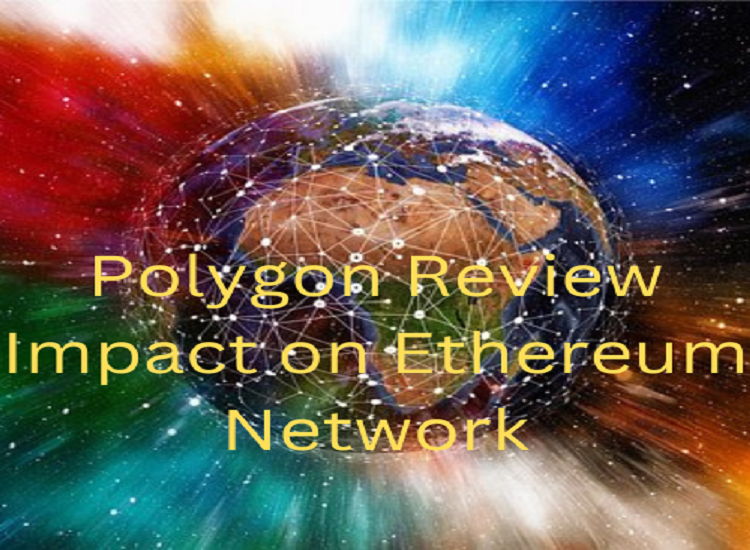Polygon helps Ethereum solve common blockchain pain points, reduces high gas fees, and increases transaction speeds without sacrificing security. Ethereum’s merger with Polygon improved the network’s lack of efficiency and scalability and it became more environmentally friendly. It is known as ‘Ethereum’s Internet of Blockchains’ because its primary function is to support the multichain Ethereum and connect it with other blockchains and decentralized applications.
What is Polygon?
Polygon is an interchain scaling solution formerly known as MATIC network that enables infrastructure for creating blockchain networks that can interface with each other. It eliminates the hassles developers face in building scalable user-friendly Dapps making the alt chains scalable and adaptable to the Ethereum security, liquidity, and interoperability. The network is an Ethereum-native, like a secondary network or layer on top of Ethereum’s main blockchain. It is aligned to operate with all of Ethereum’s existing and future infrastructure.
Polygon was created in an effort to find solutions to the Ethereum network problem. It believes in “Web3 for All” and functions through commit chains and transaction networks that operate adjacent to the main blockchain. The network retains its native cryptocurrency MATIC after merging with Ethereum to be used for fees, staking, and more.
MATIC is staked on the Polygon blockchain, allowing users to earn annually for validating transactions on the network. The developers have stack solutions on a single network, which gives them control and customization for scaling to any application. Any standalone sidechain would be a dedicated PoS bridge network on the Ethereum Blockchain.
How Does Polygon Solution Work?
Polygon Layer 1
Layer-1 scaling solutions support the base layer of the blockchain protocol itself in order to improve scalability. A Layer 1 solution will alter the original blockchain’s rules and operations. A parallel network will employ a separate parallel network to enable transactions away from the main chain. Layer 1 blockchains include Bitcoin and Ethereum.
Layer 2 scaling solutions
As previously stated, Layer 2 solutions rely on supplementary networks operating parallel or independently of the main chain. It is symbolic of Ethereum and Polygon blockchains. Polygon layer 2 scale platform allows Ethereum base applications to tackle the issues of Ethereum. Instagram, Adidas, Prada, etc., recently launched their NFT on Polygon. The network hosts over 19,000 Dapps and many industry heavyweights have migrated from Ethereum to the Polygon blockchain. In the Polygon network, the coin is still called the Matic coin.
Rollups: – Zero-knowledge rollups combine off-chain Layer 2 transactions and present them as a single transaction on the main chain. A smart bridging contract holds assets on the original chain, and the intelligent contract certifies the rollup is working correctly. It maintains the original network’s security while benefiting from a less resource-intensive rollup.
Sidechains: – Sidechains are autonomous blockchain networks with validators. The main chain’s bridge smart contract does not validate the sidechain network. It would help if you trusted the sidechain’s ability to govern assets on the primary chain.
State channels: – Two-way communication environment between parties. The parties encrypt a portion of the underlying blockchain and link it to an off-chain transaction channel.
Nested blockchains: – The system is based on a collection of subsidiary chains that sit above the primary “parent” chain. Day-to-day operations are outsourced to “child” chains, which return processed transactions to the main chain upon completion.
Usefulness to Ethereum
- Polygon is built on top of Ethereum.
- Polygons not only increase speed or cut transaction fees but creates protocols that link Ethereum Virtual Machine (EVM) compatibility with each other.
- Polygon does not compete with Ethereum; instead, Polygon is dependent on Ethereum to function.
- The developers can access the benefit using other blockchain platforms for a meager fee.
- Polygon network infrastructure handles larger transaction volumes with the Ethereum blockchain.
Polygon VS Ethereum Blockchain
Polygon is focused on low fees, quick throughput, and scalability. In contrast, the Ethereum blockchain is focused on functionality and security. Recently, on September 6 at 11:34 UTC, Ethereum successfully merged its original Mainnnet with a separate Proof-of-Stake Blockchain called Beacon Chain. Switching from Proof of Work (PoW) consensus to Proof of Stake (PoS) makes the Ethereum network the first blockchain to convert from Proof-of-Work to Proof-of-Stake for more energy efficiency.
Polygon Transaction Speed Table
Etherium is unquestionably the market leader in DeFi and cryptocurrency ventures. The Polygon PoS provides a transaction speed of around 72000 tx/sec, compared to Ethereum’s 15 transactions/sec.
| Name | Ethereum Blockchain | Polygon Blockchain |
| Architecture | Stateful architecture | Multichain architecture |
| Scalability | Limited Scalability | Multichain solutions to offer better scalability |
| Transaction Speed | 15 TPS | 72,000 TPS |
Polygon VS Ethereum Growth
- Polygon is ranked 13th in market capitalization among the top cryptocurrencies. It is currently worth $ 1 billion, making Ethereum the second-largest cryptocurrency after Bitcoin, and currently worth more than $ 243 billion.
- It is an ERC20 token built on Ethereum. Ethereum is the mother blockchain that allows Polygon to function.
- Polygon enables interoperability and scalability between Ethereum and other blockchains. Ethereum aids the development of decentralized products such as NFTs and dApps.
- Polygon is a blockchain network that uses Proof of Stake (PoS). Ethereum is still a blockchain network based on Proof of Work (PoW) (although Ethereum 2.0 is not that far off).
- You can stake Polygon MATIC tokens to receive regular rewards. You can’t stake Ethereum tokens directly except through the DEX network.
- An average network fee of Polygon in 2022 will move from $0.0005 to $0.2. It has been rising but is predicted to rise to $0.66 in July 2022. messari.io shows ETH’s average transaction fee in August was $1.64.
What Type of Blockchain is Ethereum?
Ethereum is a decentralized blockchain platform, it establishes a peer-to-peer network that securely executes and verifies application code called smart contracts. The smart contracts allow participants to transact with each other without a central trusted authority.
The rise of decentralized finance (DeFi) brought thousands of new users to the Ethereum network. These are users interested in interacting with protocols that let them earn interest on their cryptocurrency holdings, take loans, or trade on decentralized platforms.
Ethereum was the first cryptocurrency blockchain to support smart contracts, but its transaction output is limited. Users can use advanced solutions to save gas but some ETH users are trying to pay small transaction fees to move their funds. As more users interacted with an increased number of smart contracts, Ethereum network utilization continued growing up to 97.81 percent according to Etherscan.
Ethereum network could only handle 15 transactions per second. Ethereum 2.0 was created to help ETH scale to handle a higher number of transactions per second and reduce high transaction fees. The first stage in the Ethereum 2.0 development roadmap launched by the contract is Beacon Chain. This is a chain running along the main Ethereum network but uses a Proof -of -Stake consensus algorithm.
What is Ethereum Compatible Blockchain?
Compatibility with the Ethereum Virtual Machine (EVM) means the smart contracts deployed on the Ethereum Network can be easily deployed on the blockchain. It means creating an EVM-like code execution environment that makes it easier for Ethereum developers to migrate smart contracts to an EVM-compatible chain without the need to write the code over again. Popular EVM-chains are BSC, Polygon, HECO.
Impact Ethereum Compatible Blockchain
Polygon enables an easy framework for existing and new blockchain projects to build on Ethereum without scalability issues. It addresses network challenges by handling transactions on a separate Ethereum-compatible blockchain. Users can comfortably interact Dapp without having to worry about network congestion. Polygon returns transactions to the main Ethereum blockchain before processing. This process lowers the Ethereum network load and enables Polygon to speed up transactions, and lower costs to less than a cent.
Polygon interacts with the Ethereum blockchain by functioning through Commit Chains, these are transaction networks that operate side by side with the main blockchain. The Commit Chains hold batches of transactions together and confirm them in mass before returning the data to the main chain.
Polygon was built by developers for developers, it combines the best of Ethereum and sovereign blockchain into a fully developed multi-chain system. Ethereum has now moved to the PoS which will allow it to fix the platform limitations. Polygon uses the PoS consensus which enables better performance than the PoW and provides PoW security layer to the blockchains launched on Polygon.
Recently, Ethereum embarked on an update that migrated the Ethereum blockchain code to a less energy-intensive system. The merge was officially kick-started by Bellatrix on September 6 at 11:34 UTC. Bellatrix is a network upgrade on the consensus layer. It is an update to the Ethereum virtual machine which is the part of the network that hosts the decentralized applications, Daaps.
Ethereum network became one of the first blockchains to convert from Proof-of-Work to Proof-of-Stake for more energy efficiency. It will provide improved security, better performance, and higher scalability to the network based on the Ethereum foundation. The upgrade will pave way for the implementation of the Ethereum 2:0 network.
Frequently Asked Questions
- Question: Is it better to use Polygon or Ethereum?
Answer: While the Ethereum platform is focused on functionality and security, Solana and Polygon are focused on low fees, quicker speeds, and scalability.
- Question: What is the advantage of Polygon (MATIC)?
Answer: Polygon decreases gas costs while improving transaction speed. The Polygon protocol handles 72,000 transactions in the same time frame.
- Question: What is the relationship between Polygon and Ethereum?
Answer: MATIC tokens manage, secure, and pay transaction fees on the Polygon network. Polygon employs a modified proof-of-stake consensus technique.
- Question: Is Polygon’s address the same as Ethereum’s?
Answer: Polygon and Ethereum utilize the same format for wallet addresses, and you could sign transactions for both chains with the same private key.
- Question: How does Polygon Matic make money?
Answer: The only way to make money on MATIC is staking. Validators are in charge of verifying recent transactions and adding them to the blockchain.






